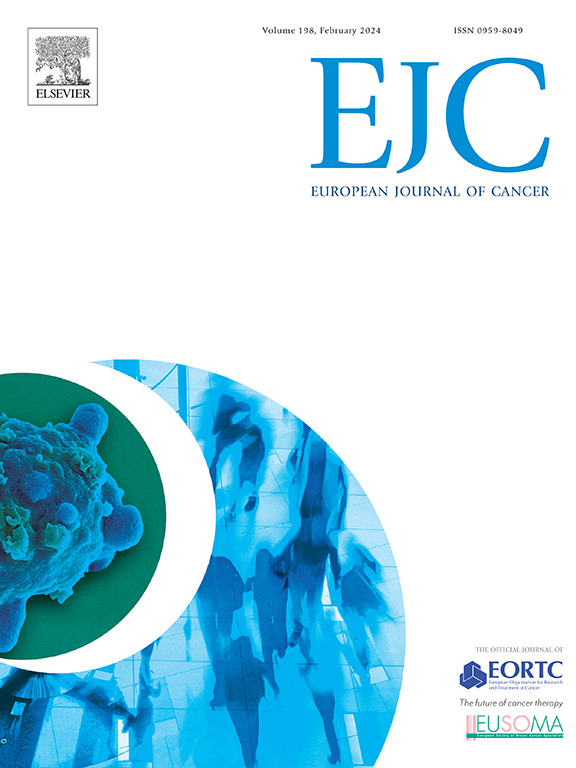Insights on the association of anthropometric and metabolic variables with tumor features and genomic risk in luminal early breast cancer: Results of a multicentric prospective study
IF 7.6
1区 医学
Q1 ONCOLOGY
引用次数: 0
Abstract
Background
Hormone receptor-positive (HR+)/HER2-negative (HER2-) early-stage breast cancers (EBC) are treated with adjuvant endocrine therapy (ET), with chemotherapy (CT) reserved for high-risk cases. Obesity is linked to increased recurrence risk. The Oncotype DX® assay predicts prognosis and CT benefit. The PRO BONO study evaluated Oncotype DX test's impact on treatment decisions and explored associations between genomic risk, tumor features, and patient metabolic profiles.
Materials and Methods
Patients with HR+ /HER2-EBC undergoing Oncotype DX testing were enrolled. Body mass index (BMI), tumor characteristics (ER, PR, Ki67, grading, size, nodal status), a large panel of metabolic analytes, and Oncotype DX Recurrence Score® (RS) results were collected. Treatment recommendations (ET vs CT-ET) were recorded pre- and post-Oncotype DX, and concordance was determined using Cohen’s Kappa. Associations were tested using Chi-Square test and Spearman Correlation.
Results
Of the 248 EBC patients (2019–2021), Oncotype DX testing reduced CT use by 47.7 %. Higher RS positively correlated with serum triglycerides and inversely with GIP (all p < 0.05). No significant association was found between patient BMI and RS result. Conversely, tumor size positively correlated with BMI (p = 0.0286) and with serum levels of leptin (p = 0.0079), PAI-1 (p = 0.0083), C-peptide (p = 0.0124), GIP (p = 0.0036), GLP-1 (p = 0.0476), glucagon (p = 0.0224), and insulin (p = 0.0327). A BMI≥ 30 and higher GLP-1 levels (>148.85pg/ml) were independently associated with increased odds of having larger tumor size (>2 cm).
Conclusions
Recurrence Score result significantly impacts treatment decisions in HR+ /HER2-EBC. RS result was not associated with BMI, although unfavorable metabolic profiles and obesity-related markers correlated with larger tumors. These findings highlight the need to further investigate the link between metabolic profiles and breast cancer biology.
一项多中心前瞻性研究的结果:人体测量学和代谢变量与腔内早期乳腺癌肿瘤特征和基因组风险的关联
激素受体阳性(HR+)/HER2阴性(HER2-)早期乳腺癌(EBC)的治疗采用辅助内分泌治疗(ET),化疗(CT)保留给高危病例。肥胖与复发风险增加有关。Oncotype DX®检测预测预后和CT获益。PRO BONO的研究评估了Oncotype DX测试对治疗决策的影响,并探讨了基因组风险、肿瘤特征和患者代谢谱之间的关系。材料和方法纳入接受Oncotype DX检测的HR+ /HER2-EBC患者。收集身体质量指数(BMI)、肿瘤特征(ER、PR、Ki67、分级、大小、淋巴结状态)、大量代谢分析和Oncotype DX复发评分(RS)结果。记录oncotype DX前后的治疗建议(ET vs CT-ET),并使用Cohen’s Kappa测定一致性。采用卡方检验和Spearman相关进行相关性检验。结果在248例EBC患者(2019-2021)中,Oncotype DX检测减少了47.7% %的CT使用。RS升高与血清甘油三酯呈正相关,与GIP呈负相关(p均为 <; 0.05)。患者BMI与RS结果无显著相关性。相反,肿瘤大小与BMI呈正相关(p = 0.0286)和血清水平的瘦素(p = 0.0079),PAI-1 (p = 0.0083),c -肽(p = 0.0124),吉普赛人(p = 0.0036),GLP-1 (p = 0.0476),胰高糖素(p = 0.0224)、胰岛素(p = 0.0327)。BMI≥ 30和较高的GLP-1水平(>148.85pg/ml)与较大肿瘤大小(>2 cm)的几率增加独立相关。结论复发评分结果显著影响HR+ /HER2-EBC患者的治疗决策。RS结果与BMI无关,尽管不利的代谢特征和肥胖相关标志物与较大的肿瘤相关。这些发现强调了进一步研究代谢谱与乳腺癌生物学之间联系的必要性。
本文章由计算机程序翻译,如有差异,请以英文原文为准。
求助全文
约1分钟内获得全文
求助全文
来源期刊

European Journal of Cancer
医学-肿瘤学
CiteScore
11.50
自引率
4.80%
发文量
953
审稿时长
23 days
期刊介绍:
The European Journal of Cancer (EJC) serves as a comprehensive platform integrating preclinical, digital, translational, and clinical research across the spectrum of cancer. From epidemiology, carcinogenesis, and biology to groundbreaking innovations in cancer treatment and patient care, the journal covers a wide array of topics. We publish original research, reviews, previews, editorial comments, and correspondence, fostering dialogue and advancement in the fight against cancer. Join us in our mission to drive progress and improve outcomes in cancer research and patient care.
 求助内容:
求助内容: 应助结果提醒方式:
应助结果提醒方式:


